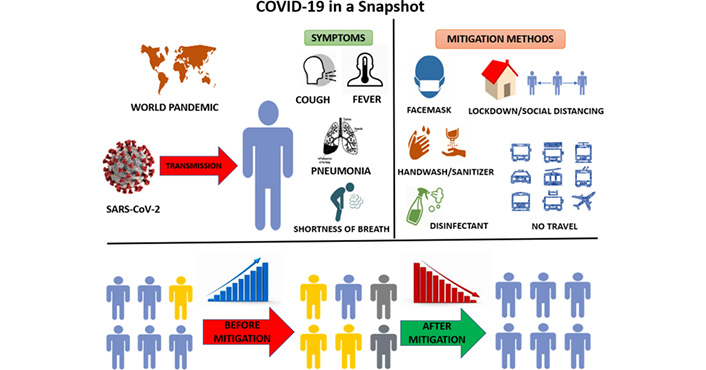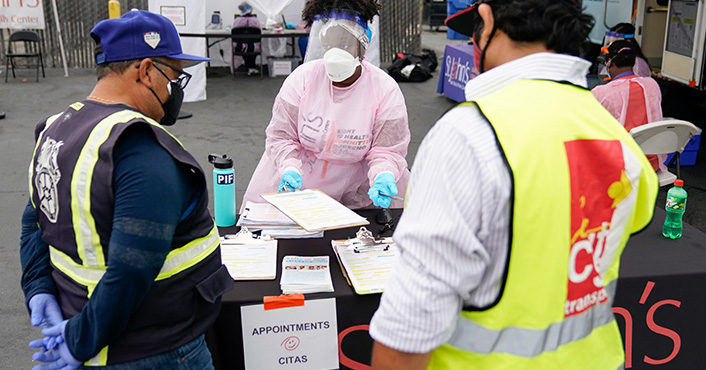Exposure to the Severe Acute Respiratory Syndrome Coronavirus 2 (SARS-CoV-2) from contaminated surfaces is not the primary mode of COVID-19 transmission. Nevertheless, it can happen.
After all, there is empirical evidence that the coronavirus is viable on surfaces for hours and days, depending on the type of surface, with stainless steel and plastic surfaces providing the highest stability for the virus.(1)
That means frequently touched surfaces contaminated with the virus are a feasible source of COVID-19 transmission.(2)
As a preventative measure, to counter coronavirus transmission via contaminated surfaces, regular cleaning and disinfection should be done in community facilities and other public contexts.

1. The Purpose of this Guide
Cleaning and disinfecting surfaces in areas and rooms occupied by persons with confirmed or suspected COVID-19 infection limits the survival of the coronavirus on such surfaces.
However, the cleaning and disinfection processes must follow specific guidelines.
That is why this guide discusses the best practices and tips for cleaning and disinfecting community facilities where confirmed or suspected coronavirus cases are reported.
2. Definitions to Keep in Mind
To fully grasp the core of this cleaning and disinfection guide, you should note the meaning of the following terms:
- Community Facilities refer to public service settings that are not healthcare facilities. They include work offices, business premises, daycare centers, schools and institutions of higher learning, and other community facilities that house people during the day or overnight.
- Cleaning describes the removal of dirt and other germs and impurities from surfaces. While cleaning alone will not kill the coronavirus and other germs, it reduces their population on such surfaces and, consequently, the risk of transmission.
- Disinfection implies sanitizing surfaces with disinfectants or other recommended chemicals. It differs from cleaning because it does not eliminate dirt but only kills germs and viruses.
As such, preceding disinfection with cleaning facilitates the elimination of germs and viruses, minimizing the risk of infection.

3. Locations and Surfaces of Target for Cleaning and Disinfection
Cleaning and disinfecting community facilities that house people overnight requires a different approach from those where people frequent only during the day.
Additionally, cleaners should target items and surfaces that are touched frequently more than those less touched.
To clean community facilities where people don’t stay overnight, follow these recommendations:
- Seal off all the areas frequented by the person confirmed or suspected to be a coronavirus case.
- Open the doors and windows to increase air circulation and start ventilating fans where possible. Wait for at least 24 hours before starting the cleaning and disinfection process.
- After the recommended wait time, clean all surfaces and equipment in the room, including the screens and keyboards of shared electronic devices, bathroom surfaces, and teller machine keypads and interfaces. You should give special attention to frequently touched surfaces such as door knobs and working tables.
To clean community facilities where people stay overnight, follow these recommendations:
- Isolate the suspected or confirmed case and provide alternative housing. Consider as a guidethe CDC’s Interim Guidance for Administrators of U.S. Institutions of Higher Education. Effectively adapt the guidelines to your community facility.
- Seal off rooms and areas previously frequented by the suspected or confirmed coronavirus case.
- Ventilate the room for at least 24 hours before cleaning and disinfecting by opening the doors and windows and running any available ventilating fans.
- Extend the cleaning and disinfection precaution to the space where the suspected or confirmed sick person is isolated. This means regularly cleaning areas frequented by those attending to the sick person and, once in a while, targeting bathrooms and bedrooms used by the person.
Cleaning the sick person's space should follow the CDC’s precautionary measures in the cleaning and disinfection for households, including avoiding contact with the sick person by targeting only dirty surfaces and items.
4. When to Clean and Disinfect Surfaces
- Clean frequently touched surfaces regularly. Depending on the community facility, these surfaces include door handles, work tables, countertops, common-use pens, shopping carts, stair rails, touchscreens and keypads, elevator push buttons, and restroom surfaces and fixtures.
- Clean less frequently touched surfaces when visibly dirty. These include floors and side tables.
- Resume normal cleaning routines 7 days after the visit of the person with confirmed or suspected coronavirus infection. That should be enough time to ensure no more viable viruses remain on the surfaces.
5. What to Target and How to Safely Clean and Disinfect
Different community facilities have different types of surfaces. Whichever the type of surface, however, the purpose is to safely clean and disinfect the surfaces with the most effective disinfectant for killing the coronavirus.
Cleaning and Disinfecting Hard, Non-porous Surfaces
Hard surfaces include desks and work tables, countertops, floors, and power switches.
To clean and disinfect these surfaces:
- Start by cleaning these surfaces with soap/detergent and water.
- Proceed to disinfect with an EPA-registered disinfectant. You can use the EPA List N Toolto find disinfectants that kill all coronavirus strains. Be sure to follow manufacturer instructions to a tee.
- As an alternative, consider a diluted solution of household bleach for surfaces resistant to the chemical, such as tiled floors, sinks, and marble countertops.(3)The bleach should have at least 1000ppm sodium chloride. Mix the solution in a 5:1 ratio (5 tbsp bleach in a gallon of water). Allow the bleach to sit on the surface for at least one minute before rinsing.
If you go for the bleach solution:
- Be sure to wear gloves to protect your hands.
- Ensure the room is well-ventilated to help disperse bleach fumes.
- Pay attention not to inhale the bleach fumes.
- Avoid expired products.
- Don’t mix bleach with other products like ammonia.
Cleaning and Disinfecting Soft, Porous Surfaces
Soft, porous surfaces include rugs, carpets, and curtains or blinds. To clean and disinfect these surfaces:
- First, remove any apparent contamination. This could be from the sick person’s vomit or other body fluids.
- Clean the surface with the recommended detergents.
- Launder washable items following manufacturer instructions and with the warmest water setting allowed. Spread, and allow them to dry completely.
- Use EPA-approved disinfectants, those recommended for porous surfaces.
Cleaning and Disinfecting Washable Items
Washable items are those that can be laundered. They include clothing and linen.
Take extra care when cleaning and disinfecting these items because they can get quite close to your body when laundering them.
Follow these guidelines when cleaning and disinfecting washable items:
- Place the items into the washing machine without shaking or spreading them out to avoid releasing the virus into the air. It is ok to wash the sick person’s clothes with the rest of the laundry as the virus won’t survive the washing conditions.
- Set the water temperature to the highest level allowed by manufacturer instructions, depending on the fabric type.
- Once washed, spread the items and allow them to dry completely.
- Clean and disinfect laundry carts and baskets following the appropriate cleaning and disinfection guidelines for hard and soft surfaces.
Cleaning and Disinfecting Electronics
Electronics are delicate devices when it comes to cleaning and disinfection. However, if they are meant for public use, their remote controls, screens, keyboards, or user interfaces can act as surfaces of coronavirus transmission.
To clean and disinfect electronics:
- Start by getting rid of any visible contamination.
- Follow manufacturer instructions to clean and disinfect specific electronic devices. If these are unavailable, use 70% alcohol-based sprays or wipes. 90% grade alcohol is preferred as it evaporates faster.(4)Be sure to dry the surfaces completely.
- Consider using covers that can be safely wiped or cleaned on electronic devices.
Cleaning and Disinfecting Outdoor Spaces
The outdoors has continuous air exchange. For that reason, it is enough to follow the usual cleaning procedures for surfaces such as play structures and grab bars. Clean these spaces only when they appear dirty.
Also, low surfaces like pathways and groundcovers don’t need special cleaning or disinfection. Usual cleaning and maintenance routines should suffice.
Similarly, roadside benches and wooden surfaces or structures outside buildings do not require special cleaning or disinfection procedures.
Personal Protection When Cleaning and Disinfecting
The risk of coronavirus exposure to cleaning staff is considered low.
Nonetheless, community facility staff cleaning and disinfecting should protect themselves with Personal Protective Equipment (PPE) and observe hand hygiene.
Specifically, they should observe the following precautions when cleaning and disinfecting:
- Wear disposable gowns and gloves when performing any cleaning task or handling trash. These should be suitable for the type of detergent and disinfectant. Additional protection should be considered for harsh detergents and disinfectants and where a splash would pose a danger.
- If gowns are unavailable, substitute them with aprons, work outfits, or overalls, and launder them after finishing cleaning. The guidelines for laundering linen and clothing indicated earlier apply in this case.
- Remove gowns and gloves with utmost care to avoid contaminating yourself and your surroundings.
- Observe hand hygiene after removing gowns and gloves by washing your hands with soap and running water for at least 20 seconds. Performing hand hygiene should never be skipped when hands are visibly dirty. However, if water and soap are unavailable and hands are not visibly dirty, a 60% alcohol hand sanitizer or higher should be used to sterilize the hands.
- Gowns and gloves used when cleaning space occupied by the sick person should not be kept on when cleaning other places. Remove them immediately and dispose of them safely, then wash your hands and wear a new set to clean the other areas.
- Never use PPEs with breaches such as tears or holes when cleaning and disinfecting. These facilitate exposure, and you should discard them after reporting their condition to the appropriate supervisors.
- Do not touch your eyes, mouth, or nose during the cleaning and disinfection process and before observing hand hygiene after cleaning. Observe hand hygiene always while at the community facility during these other times:
-
- Before and after providing care to other healthy persons in the community facility, such as children and the elderly.
- After a visit to the restroom.
- After sneezing, coughing, or blowing your nose.
- Before food preparation and before eating.
- After interacting with pets and other animals.
6. Recommendations for Employers and Other Community Facility Supervisors
Employers or their representing facility supervisors have a duty to protect community facility cleaners. They should ensure that these workers observe all prevention-from-exposure protocols for themselves and others in the facility.
Specifically, employers and supervisors should:
- Participate in state and local efforts to stop the spread of the coronavirus by:
- Developing worker protection policies in line with the relevant Occupational Safety and Health Administration (OSHA) standards, including those on Bloodborne Pathogensand proper disposal of regulated waste (29 CFR 1910.1030) and PPE usage (29 CFR 1910.132, subpart I).
- Work with state and local health agencies to ensure they are up to date with cleaning and disinfection protocols and the identification of COVID-19 symptoms in possible infection cases.
- Train workers in personal protection and the protection of those around them by:
- Performing drills on cleaning and disinfection processes, laundering clothing and linen, and handling trash. Do this before assigning any cleaning duties at the facility.
- Training workers to identify COVID-19 symptoms and the appropriate decisions and actions to take in such cases, including quarantining after exposure and isolation following a positive COVID-19 test.(5)Workers must be aware of the need to inform their supervisors and the local healthcare department should they or others develop coronavirus symptoms.
- Train workers on key PPE issues: what PPE to use, when to use PPE, how to use PPE, and how to safely dispose of used PPE.
- Train workers on the dangers of cleaning and disinfecting chemicals used in the facility as per OSHA’s Hazard Communicationstandards (29 CFR 1910.1200), including labeling all cleaning and disinfecting chemicals and reading labels before use.
- Train workers on the importance of proper ventilation during cleaning and disinfection and at all other times to ensure healthy air circulation.
7. Final Note
The coronavirus transmission rate through contaminated surfaces is considered minimal but possible. For this reason, surfaces must be kept clean and disinfected when confirmed or suspected coronavirus cases are identified in community facilities.
This cleaning and disinfection guide for community facilities has details on what to clean and disinfect, how to perform cleaning and disinfection processes, and how to protect oneself when cleaning and disinfecting.
The cleaning and disinfection guidelines in this write-up are exclusive to community facilities (work offices, business premises, daycare centers, schools, and institutions of higher learning). They are not intended for healthcare settings or other facilities with unique characteristics, such as food service businesses.
REFERENCES
1.N van Doremalen, et al. Aerosol and surface stability of HCoV-19 (SARS-CoV-2) compared to SARS-CoV-1. The New England Journal of Medicine (2020); 382:1564-1567. DOI:10.1056/NEJMc2004973.





